transmission INFINITI FX35 2008 Service Manual
[x] Cancel search | Manufacturer: INFINITI, Model Year: 2008, Model line: FX35, Model: INFINITI FX35 2008Pages: 3924, PDF Size: 81.37 MB
Page 1 of 3924

ABCDEFGHIJKLQUICK REFERENCE INDEX AGENERAL INFORMATIONGIGeneral InformationBENGINEEMEngine MechanicalLUEngine Lubrication SystemCOEngine Cooling SystemECEngine Control SystemFLFuel SystemEXExhaust SystemACCAccelerator Control SystemCTRANSMISSION/
TRANSAXLEATAutomatic TransmissionDDRIVELINE/AXLETFTransferPRPropeller ShaftFFDFront Final DriveRFDRear Final DriveFAXFront AxleRAXRear AxleESUSPENSIONFSUFront SuspensionRSURear SuspensionWTRoad Wheels & TiresFBRAKESBRBrake SystemPBParking Brake SystemBRCBrake Control SystemGSTEERINGPSPower Steering SystemHRESTRAINTSSBSeat BeltsSRSSupplemental Restraint System
(SRS)IBODYBLBody, Lock & Security SystemGWGlasses, Window System & Mir-
rorsRFRoofEIExterior & InteriorIPInstrument PanelSESeatJAIR CONDITIONERATCAutomatic Air ConditionerKELECTRICALSCStarting & Charging SystemLTLighting SystemDIDriver Information SystemWWWiper, Washer & HornBCSBody Control SystemLANLAN SystemAVAudio Visual, Navigation & Tele-
phone SystemACSAuto Cruise Control SystemPGPower Supply, Ground & Circuit Ele-
mentsLMAINTENANCEMAMaintenanceEdition: April 2007
Revision: April 2007
Page 4 of 3924

QUICK REFERENCE CHART FX35/FX45
REAR WHEEL ALIGNMENT (Unladen*)
ELS0003Y
* : Fuel, engine coolant and engine oil full. Spare tire, jack, hand tools and mats in designated positions.
BRAKEELS0003Z
* : Under force of 490 N (50 kg, 110 lb) with engine running.
REFILL CAPACITIESELS00040
Camber
Degree minute (Decimal degree)Minimum –1° 18′ (–1.30°)
Nominal –0° 48′ (–0.80°)
Maximum – 0° 18′ (– 0.30°)
Total toe-inDistance Minimum 2.4 mm (0.09 in)
Nominal 4.7 mm (0.19 in)
Maximum 7.0 mm (0.28 in)
Angle (left wheel or right wheel)
Degree minute (Decimal degree)Minimum 0° 05′ (0.08°)
Nominal 0° 10′ (0.17°)
Maximum 0° 15′ (0.25°)
Front brake Pad repair limit 2.0 mm (0.079 in)
Rotor wear limit 32.0 mm (1.260 in)
Rear brake Pad repair limit 2.0 mm (0.079 in)
Rotor wear limit 14.0 mm (0.551 in)
Pedal free height 161.5 - 171.5 mm (6.358 - 6.752 in)
Pedal depressed height* More than 95 mm (3.74 in)
UNITLiter US measure
Fuel tank90 23 - 3/4 gal
Coolant (With reservoir tank)VQ35DE 8.6 9 - 1/8 qt
VK45DE 10.0 10 - 5/8 qt
Engine (VQ35DE)Drain and refill
With oil filter change 4.7 5 qt
Without oil filter change 4.4 4 - 5/8 qt
Dry engine (Overhaul) 5.4 5 - 3/4 qt
Engine (VK45DE)Drain and refill
With oil filter change 5.8 6 - 1/8 qt
Without oil filter change 5.2 5 - 1/2 qt
Dry engine (Overhaul) 7.0 7 - 3/8 qt
Transmission A/T 10.3 10 - 7/8 qt
Transfer1.25 2 - 5/8 pt
Differential carrierFront 0.65 1 - 3/8 pt
Rear 1.4 3 pt
Power steering system 1.0 1 - 1/8 qt
Air conditioning systemCompressor oil 0.18 6.0 fl oz
Refrigerant 0.55 kg 1.21 lb
2008
Page 16 of 3924
![INFINITI FX35 2008 Service Manual
DESCRIPTIONACS-9
< SERVICE INFORMATION > [ICC]
C
D
E
F
G H
I
J
L
M A
B
ACS
N
O P
ACTIVE TEST ITEM LIST
Component DescriptionINFOID:0000000001328807
CAN CommunicationINFOID:0000000001328808
CAN (Contr INFINITI FX35 2008 Service Manual
DESCRIPTIONACS-9
< SERVICE INFORMATION > [ICC]
C
D
E
F
G H
I
J
L
M A
B
ACS
N
O P
ACTIVE TEST ITEM LIST
Component DescriptionINFOID:0000000001328807
CAN CommunicationINFOID:0000000001328808
CAN (Contr](/img/42/57017/w960_57017-15.png)
DESCRIPTIONACS-9
< SERVICE INFORMATION > [ICC]
C
D
E
F
G H
I
J
L
M A
B
ACS
N
O P
ACTIVE TEST ITEM LIST
Component DescriptionINFOID:0000000001328807
CAN CommunicationINFOID:0000000001328808
CAN (Controller Area Network) is a serial communication li ne for real time application. It is an on-vehicle mul-
tiplex communication line with high data communication speed and excellent error detection ability. Many elec-
tric control units are equipped onto a vehicle, and eac h control unit shares information and links with other
control units during operation (not independent). In CAN communication, control units are connected with 2
communication lines (CAN-H line, CAN-L line) allowing a high rate of information transmission with less wiring.
Each control unit transmits/receives data but selectively reads required data only.
CAN COMMUNICATION UNIT
Refer to LAN-43, "CAN System Specification Chart".
Output CONSULT-III ICC
[ACTIVE TEST]
Item CAN Description
Combination
meter ICC BUZZER 1
×Able to start ICC warning chime with a driving signal from ICC unit.
METER LAMP ×Able to turn ICC system display ON with a driving signal from ICC unit.
ICC brake hold
relay STOP LAMP Able to start ICC brake hold relay with a driving signal from ICC unit.
Booster sole-
noid BOOSTER SOL/V
3
Able to start booster solenoid with a driving signal from ICC unit.
ComponentVehicle-to-
vehicle
distance
control mode Conventional
(fixed speed)
cruise
control mode Brake assis
(with preview function) Description
ICC unit ××× Operates electric throttle control actuator and brake
booster based on that sensor signals and CAN commu-
nication data, then controls vehicle distance.
ICC sensor ×× Irradiates laser beam, and receives reflected laser beam
to measure distance from preceding vehicle.
ECM ××× Transmits throttle position signal and ICC steering switch
signal to ICC unit through CAN communication.
ABS actuator and electric
unit (control unit) ××× Transmits wheel speed sensor signal to ICC unit through
CAN communication.
Brake pressure sensor ×× Detects fluid pressure in master cylinder.
Brake booster ×× Adjusts brake fluid pressure, based on command from
ICC unit.
BCM × Transmit front wiper request signal to ICC unit through
CAN communication.
TCM ×× Transmits gear position signal and output shaft revolu-
tion signal to ICC unit through CAN communication.
Unified meter and A/C amp. ××× Receives ICC system display signal, ICC warning lamp
signal and buzzer output signal from ICC unit through
CAN communication.
ICC brake switch, stop lamp
switch ××× Transmit operating signal to ICC unit when touching
brake pedal. ICC unit cancels cruise system at driver's
brake operation.
ICC brake hold relay × Receives stop lamp driving signal from ICC unit, and
turns stop lamp ON.
Parking brake switch ×× The cruise system is cancelled when applied.
3AA93ABC3ACD3AC03ACA3AC03AC63AC53A913A773A893A873A873A8E3A773A983AC73AC93AC03AC3
3A893A873A873A8F3A773A9D3AAF3A8A3A8C3A863A9D3AAF3A8B3A8C
Page 74 of 3924
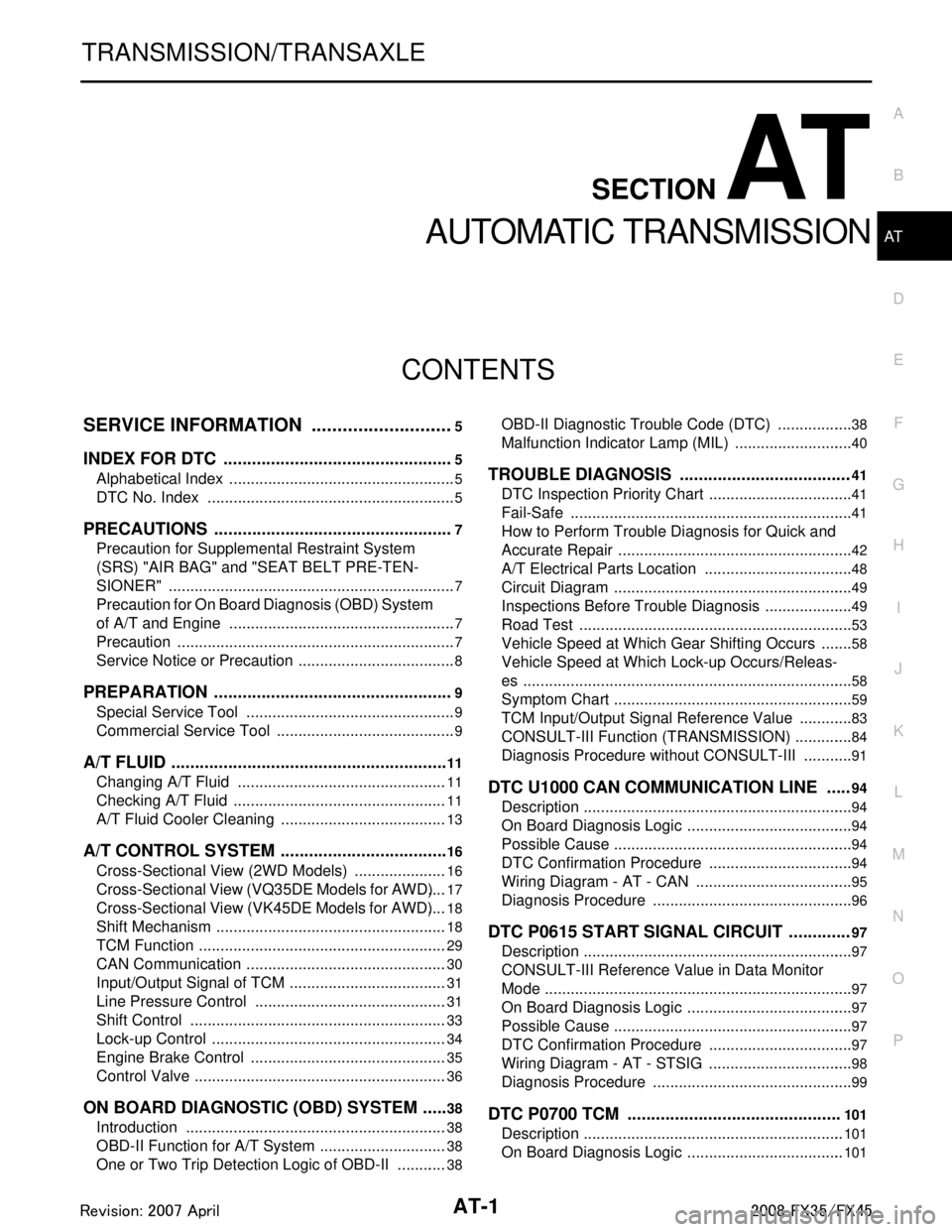
AT-1
TRANSMISSION/TRANSAXLE
DE
F
G H
I
J
K L
M
SECTION AT
A
B
AT
N
O P
CONTENTS
AUTOMATIC TRANSMISSION
SERVICE INFORMATION .. ..........................5
INDEX FOR DTC ............................................ .....5
Alphabetical Index ............................................... ......5
DTC No. Index ..........................................................5
PRECAUTIONS ...................................................7
Precaution for Supplemental Restraint System
(SRS) "AIR BAG" and "SEAT BELT PRE-TEN-
SIONER" ............................................................. ......
7
Precaution for On Board Diagnosis (OBD) System
of A/T and Engine .....................................................
7
Precaution .................................................................7
Service Notice or Precaution .....................................8
PREPARATION ...................................................9
Special Service Tool ........................................... ......9
Commercial Service Tool ..........................................9
A/T FLUID ...........................................................11
Changing A/T Fluid ............................................. ....11
Checking A/T Fluid ..................................................11
A/T Fluid Cooler Cleaning .......................................13
A/T CONTROL SYSTEM ....................................16
Cross-Sectional View (2WD Models) .................. ....16
Cross-Sectional View (VQ35DE Models for AWD) ....17
Cross-Sectional View (VK45DE Models for AWD) ....18
Shift Mechanism .................................................. ....18
TCM Function ..........................................................29
CAN Communication ...............................................30
Input/Output Signal of TCM .....................................31
Line Pressure Control .............................................31
Shift Control ............................................................33
Lock-up Control .......................................................34
Engine Brake Control ..............................................35
Control Valve ...........................................................36
ON BOARD DIAGNOSTIC (OBD) SYSTEM ......38
Introduction ......................................................... ....38
OBD-II Function for A/T System ..............................38
One or Two Trip Detection Logic of OBD-II ............38
OBD-II Diagnostic Trouble Code (DTC) .............. ....38
Malfunction Indicator Lamp (MIL) ............................40
TROUBLE DIAGNOSIS ....................................41
DTC Inspection Priority Chart ..................................41
Fail-Safe ..................................................................41
How to Perform Trouble Diagnosis for Quick and
Accurate Repair .......................................................
42
A/T Electrical Parts Location ...................................48
Circuit Diagram ........................................................49
Inspections Before Trouble Diagnosis .....................49
Road Test ................................................................53
Vehicle Speed at Which Gear Shifting Occurs ........58
Vehicle Speed at Which Lock-up Occurs/Releas-
es .............................................................................
58
Symptom Chart ........................................................59
TCM Input/Output Signal Reference Value .............83
CONSULT-III Function (TRANSMISSION) ..............84
Diagnosis Procedure without CONSULT-III ............91
DTC U1000 CAN COMMUNICATION LINE .....94
Description ........................................................... ....94
On Board Diagnosis Logic .......................................94
Possible Cause ........................................................94
DTC Confirmation Procedure ..................................94
Wiring Diagram - AT - CAN .....................................95
Diagnosis Procedure ...............................................96
DTC P0615 START SIGNAL CIRCUIT .............97
Description ...............................................................97
CONSULT-III Reference Value in Data Monitor
Mode ........................................................................
97
On Board Diagnosis Logic .......................................97
Possible Cause ........................................................97
DTC Confirmation Procedure ..................................97
Wiring Diagram - AT - STSIG ..................................98
Diagnosis Procedure ...............................................99
DTC P0700 TCM .............................................101
Description .............................................................101
On Board Diagnosis Logic .....................................101
3AA93ABC3ACD3AC03ACA3AC03AC63AC53A913A773A893A873A873A8E3A773A983AC73AC93AC03AC3
3A893A873A873A8F3A773A9D3AAF3A8A3A8C3A863A9D3AAF3A8B3A8C
Page 77 of 3924

AT-4
BRAKE SIGNAL CIRCUIT ..............................165
CONSULT-III Reference Value in Data Monitor
Mode .................................................................... ..
165
Diagnosis Procedure .............................................165
A/T INDICATOR CIRCUIT ...............................166
Description ........................................................... ..166
CONSULT-III Reference Value in Data Monitor
Mode .................................................................... ..
166
Diagnosis Procedure .............................................166
TROUBLE DIAGNOSIS FOR SYMPTOMS .....167
Wiring Diagram - AT - NONDTC .......................... ..167
A/T Check Indicator Lamp Does Not Come On .....170
Engine Cannot Be Started in "P" or "N" Position ...170
In "P" Position, Vehicle Moves When Pushed .......171
In "N" Position, Vehicle Moves ..............................172
Large Shock ("N" to "D" Position) ..........................173
Vehicle Does Not Creep Backward in "R" Position ..175
Vehicle Does Not Creep Forward in "D" Position ..178
Vehicle Cannot Be Started from D1 .......................180
A/T Does Not Shift: D1→ D2 ................................ ..182
A/T Does Not Shift: D2→ D3 ................................ ..184
A/T Does Not Shift: D3→ D4 ................................ ..186
A/T Does Not Shift: D4→ D5 ................................ ..188
A/T Does Not Lock-up ......................................... ..190
A/T Does Not Hold Lock-up Condition ...................192
Lock-up Is Not Released .......................................194
Engine Speed Does Not Return to Idle .................194
Cannot Be Changed to Manual Mode ...................195
A/T Does Not Shift: 5th Gear → 4th Gear ........... ..196
A/T Does Not Shift: 4th Gear → 3rd Gear ........... ..197
A/T Does Not Shift: 3rd Gear → 2nd Gear .......... ..199
A/T Does Not Shift: 2nd Gear → 1st Gear ........... ..201
Vehicle Does Not Decelerate by Engine Brake ... ..202
SHIFT CONTROL SYSTEM ............................205
Control Device Removal and Installation ............. ..205
Control Rod Removal and Installation ...................206
Adjustment of A/T Position ....................................207
Checking of A/T Position .......................................207
A/T SHIFT LOCK SYSTEM .............................208
Description ........................................................... ..208
Shift Lock System Electrical Parts Location ..........208
Wiring Diagram - AT - SHIFT .................................209
Diagnosis Procedure .............................................209
KEY INTERLOCK CABLE ...............................212
Component .......................................................... ..212
Removal and Installation .......................................212
ON-VEHICLE SERVICE ...................................215
Control Valve with TCM and A/T Fluid Tempera-
ture Sensor 2 ....................................................... .
215
Parking Component (2WD Models Only) ..............226
Rear Oil Seal .........................................................233
Revolution Sensor Component (2WD Models
Only) .....................................................................
233
AIR BREATHER HOSE ....................................239
Removal and Installation ...................................... .239
TRANSMISSION ASSEMBLY ..........................241
Removal and Installation (2WD Models) .............. .241
Removal and Installation (AWD Models) ..............243
OVERHAUL ......................................................249
Component .......................................................... .249
Oil Channel ...........................................................261
Location of Adjusting Shims, Needle Bearings,
Thrust Washers and Snap Rings ......................... .
264
DISASSEMBLY .............................................. ..267
Disassembly ......................................................... .267
REPAIR FOR COMPONENT PARTS ..............285
Oil Pump .............................................................. .285
Front Sun Gear, 3rd One-Way Clutch ...................287
Front Carrier, Input Clutch, Rear Internal Gear .....289
Mid Sun Gear, Rear Sun Gear, High and Low Re-
verse Clutch Hub ..................................................
295
High and Low Reverse Clutch ..............................301
Direct Clutch .........................................................303
ASSEMBLY .................................................... ..306
Assembly (1) ........................................................ .306
Adjustment ............................................................320
Assembly (2) .........................................................323
SERVICE DATA AND SPECIFICATIONS
(SDS) ................................................................
330
General Specification ........................................... .330
Vehicle Speed at Which Gear Shifting Occurs .....330
Vehicle Speed at Which Lock-up Occurs/Releas-
es ..........................................................................
331
Stall Speed ............................................................331
Line Pressure ........................................................331
A/T Fluid Temperature Sensor ..............................332
Turbine Revolution Sensor ...................................332
Vehicle Speed Sensor A/T (Revolution Sensor) ...332
Reverse Brake ......................................................332
Total End Play .......................................................332
3AA93ABC3ACD3AC03ACA3AC03AC63AC53A913A773A893A873A873A8E3A773A983AC73AC93AC03AC3
3A893A873A873A8F3A773A9D3AAF3A8A3A8C3A863A9D3AAF3A8B3A8C
Page 81 of 3924
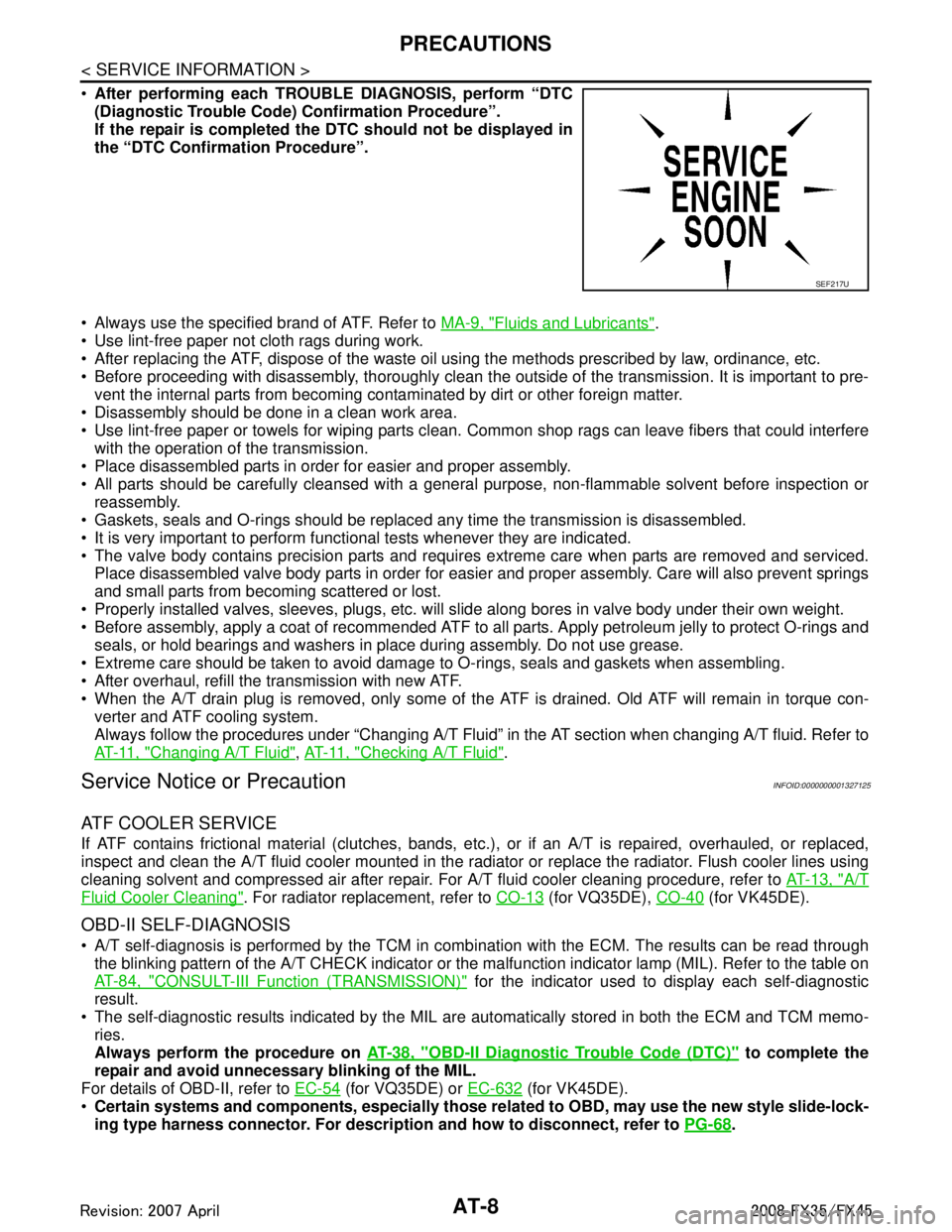
AT-8
< SERVICE INFORMATION >
PRECAUTIONS
After performing each TROUBLE DIAGNOSIS, perform “DTC
(Diagnostic Trouble Code) Confirmation Procedure”.
If the repair is completed the DTC should not be displayed in
the “DTC Confirmation Procedure”.
Always use the specified brand of ATF. Refer to MA-9, "
Fluids and Lubricants".
Use lint-free paper not cloth rags during work.
After replacing the ATF, dispose of the waste oil using the methods prescribed by law, ordinance, etc.
Before proceeding with disassembly, thoroughly clean the out side of the transmission. It is important to pre-
vent the internal parts from becoming cont aminated by dirt or other foreign matter.
Disassembly should be done in a clean work area.
Use lint-free paper or towels for wiping parts clean. Common shop rags can leave fibers that could interfere
with the operation of the transmission.
Place disassembled parts in order for easier and proper assembly.
All parts should be carefully cleansed with a general purpose, non-flammable solvent before inspection or
reassembly.
Gaskets, seals and O-rings should be replaced any time the transmission is disassembled.
It is very important to perform functional tests whenever they are indicated.
The valve body contains precision parts and requires extreme care when parts are removed and serviced. Place disassembled valve body parts in order for easier and proper assembly. Care will also prevent springs
and small parts from becoming scattered or lost.
Properly installed valves, sleeves, plugs, etc. will s lide along bores in valve body under their own weight.
Before assembly, apply a coat of recommended ATF to all parts. Apply petroleum jelly to protect O-rings and
seals, or hold bearings and washers in place during assembly. Do not use grease.
Extreme care should be taken to avoid damage to O-rings, seals and gaskets when assembling.
After overhaul, refill the transmission with new ATF.
When the A/T drain plug is removed, only some of t he ATF is drained. Old ATF will remain in torque con-
verter and ATF cooling system.
Always follow the procedures under “Changing A/T Fluid” in the AT section when changing A/T fluid. Refer to
AT- 11 , "
Changing A/T Fluid", AT- 11 , "Checking A/T Fluid".
Service Notice or PrecautionINFOID:0000000001327125
ATF COOLER SERVICE
If ATF contains frictional material (clutches, bands, etc. ), or if an A/T is repaired, overhauled, or replaced,
inspect and clean the A/T fluid cooler mounted in the radiat or or replace the radiator. Flush cooler lines using
cleaning solvent and compressed air after repair. For A/T fluid cooler cleaning procedure, refer to AT-13, "
A/T
Fluid Cooler Cleaning". For radiator replacement, refer to CO-13 (for VQ35DE), CO-40 (for VK45DE).
OBD-II SELF-DIAGNOSIS
A/T self-diagnosis is performed by the TCM in comb ination with the ECM. The results can be read through
the blinking pattern of the A/T CHECK indicator or the malfunction indicator lamp (MIL). Refer to the table on
AT-84, "
CONSULT-III Function (TRANSMISSION)" for the indicator used to display each self-diagnostic
result.
The self-diagnostic results indicated by the MIL ar e automatically stored in both the ECM and TCM memo-
ries.
Always perform the procedure on AT-38, "
OBD-II Diagnostic Trouble Code (DTC)" to complete the
repair and avoid unnecessary blinking of the MIL.
For details of OBD-II, refer to EC-54
(for VQ35DE) or EC-632 (for VK45DE).
Certain systems and components, especially those re lated to OBD, may use the new style slide-lock-
ing type harness connector. For descrip tion and how to disconnect, refer to PG-68
.
SEF217U
3AA93ABC3ACD3AC03ACA3AC03AC63AC53A913A773A893A873A873A8E3A773A983AC73AC93AC03AC3
3A893A873A873A8F3A773A9D3AAF3A8A3A8C3A863A9D3AAF3A8B3A8C
Page 85 of 3924
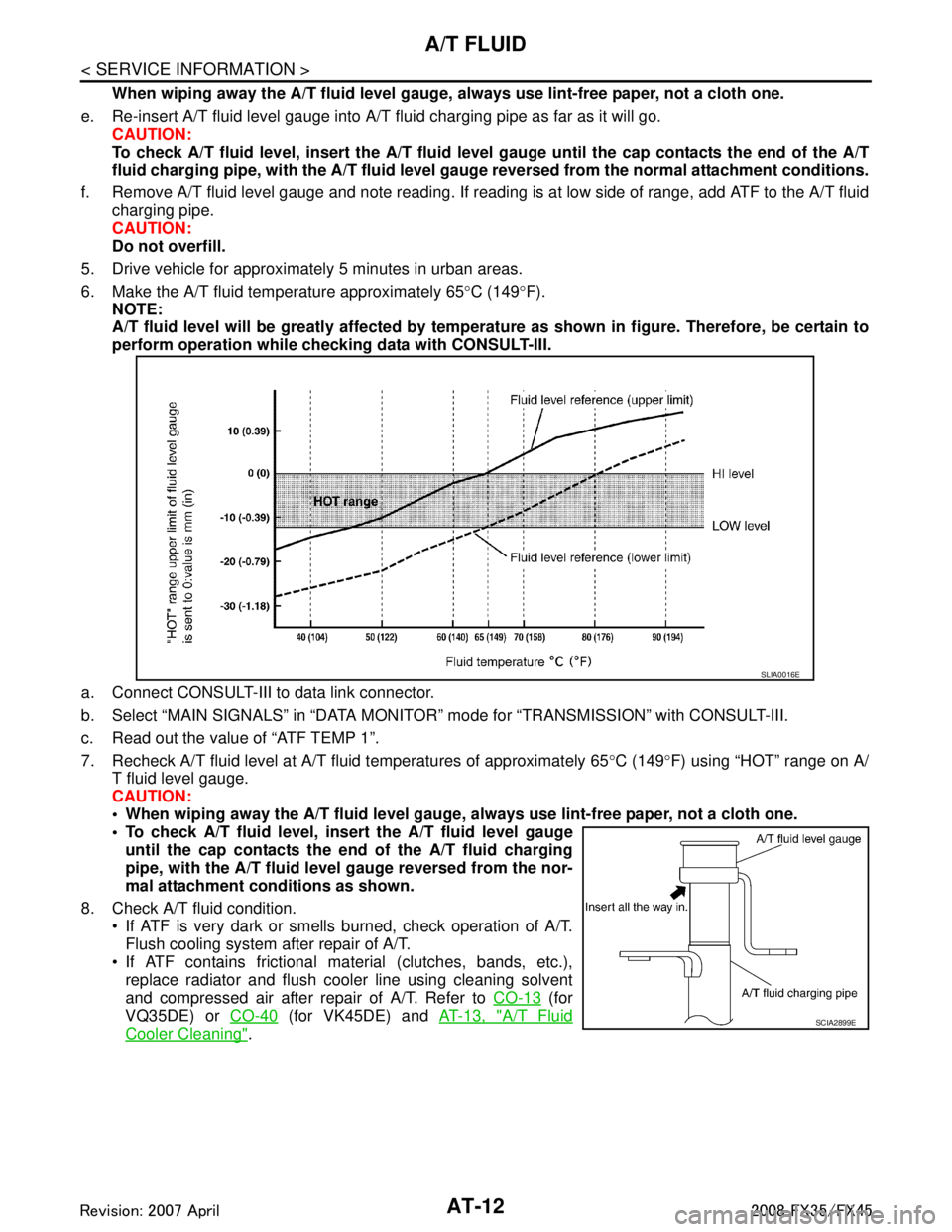
AT-12
< SERVICE INFORMATION >
A/T FLUID
When wiping away the A/T fluid level gauge, always use lint-free paper, not a cloth one.
e. Re-insert A/T fluid level gauge into A/T fluid charging pipe as far as it will go. CAUTION:
To check A/T fluid level, insert the A/T fluid level gauge until the cap contacts the end of the A/T
fluid charging pipe, with the A/ T fluid level gauge reversed from the normal attachment conditions.
f. Remove A/T fluid level gauge and note reading. If reading is at low side of range, add ATF to the A/T fluid
charging pipe.
CAUTION:
Do not overfill.
5. Drive vehicle for approximately 5 minutes in urban areas.
6. Make the A/T fluid temperature approximately 65 °C (149 °F).
NOTE:
A/T fluid level will be greatly affected by temper ature as shown in figure. Therefore, be certain to
perform operation while checki ng data with CONSULT-III.
a. Connect CONSULT-III to data link connector.
b. Select “MAIN SIGNALS” in “DATA MONITO R” mode for “TRANSMISSION” with CONSULT-III.
c. Read out the value of “ATF TEMP 1”.
7. Recheck A/T fluid level at A/T fluid temperatures of approximately 65 °C (149 °F) using “HOT” range on A/
T fluid level gauge.
CAUTION:
When wiping away the A/T fluid level gauge, always use lint-free paper, not a cloth one.
To check A/T fluid level, inser t the A/T fluid level gauge
until the cap contacts the en d of the A/T fluid charging
pipe, with the A/T fluid level gauge reversed from the nor-
mal attachment conditions as shown.
8. Check A/T fluid condition. If ATF is very dark or smells burned, check operation of A/T.
Flush cooling system after repair of A/T.
If ATF contains frictional material (clutches, bands, etc.), replace radiator and flush cooler line using cleaning solvent
and compressed air after repair of A/T. Refer to CO-13
(for
VQ35DE) or CO-40
(for VK45DE) and AT-13, "A/T Fluid
Cooler Cleaning".
SLIA0016E
SCIA2899E
3AA93ABC3ACD3AC03ACA3AC03AC63AC53A913A773A893A873A873A8E3A773A983AC73AC93AC03AC3
3A893A873A873A8F3A773A9D3AAF3A8A3A8C3A863A9D3AAF3A8B3A8C
Page 86 of 3924
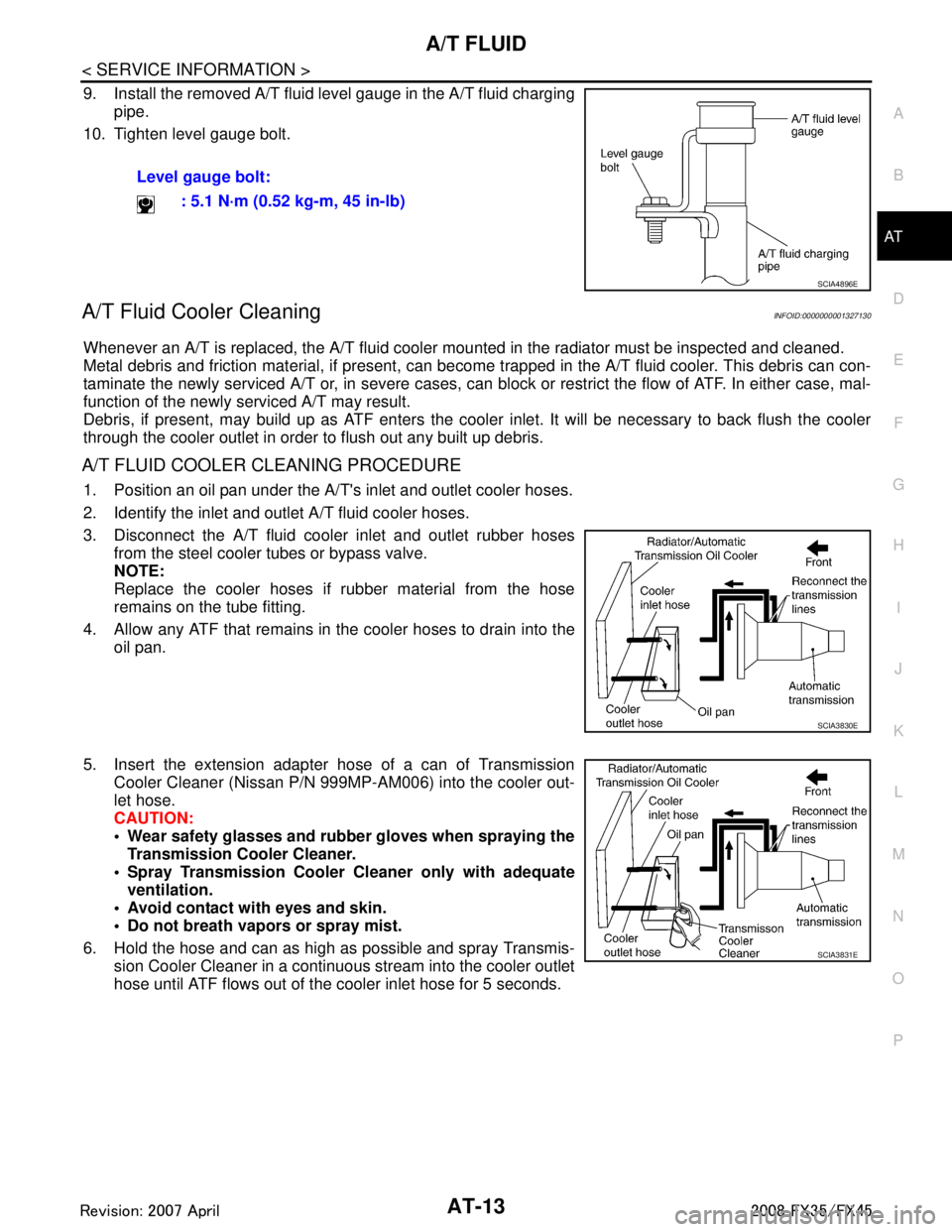
A/T FLUIDAT-13
< SERVICE INFORMATION >
DE
F
G H
I
J
K L
M A
B
AT
N
O P
9. Install the removed A/T fluid level gauge in the A/T fluid charging pipe.
10. Tighten level gauge bolt.
A/T Fluid Cooler CleaningINFOID:0000000001327130
Whenever an A/T is replaced, the A/ T fluid cooler mounted in the radiator must be inspected and cleaned.
Metal debris and friction material, if present, can becom e trapped in the A/T fluid cooler. This debris can con-
taminate the newly serviced A/T or, in severe cases, can bl ock or restrict the flow of ATF. In either case, mal-
function of the newly se rviced A/T may result.
Debris, if present, may build up as ATF enters the cooler inlet. It will be necessary to back flush the cooler
through the cooler outlet in order to flush out any built up debris.
A/T FLUID COOLER CLEANING PROCEDURE
1. Position an oil pan under the A/T's inlet and outlet cooler hoses.
2. Identify the inlet and outlet A/T fluid cooler hoses.
3. Disconnect the A/T fluid cooler inlet and outlet rubber hoses from the steel cooler tubes or bypass valve.
NOTE:
Replace the cooler hoses if rubber material from the hose
remains on the tube fitting.
4. Allow any ATF that remains in the cooler hoses to drain into the oil pan.
5. Insert the extension adapter hose of a can of Transmission Cooler Cleaner (Nissan P/N 999MP-AM006) into the cooler out-
let hose.
CAUTION:
Wear safety glasses and rubber gloves when spraying theTransmission Cooler Cleaner.
Spray Transmission Cooler Cleaner only with adequate
ventilation.
Avoid contact with eyes and skin.
Do not breath vapors or spray mist.
6. Hold the hose and can as high as possible and spray Transmis- sion Cooler Cleaner in a continuous stream into the cooler outlet
hose until ATF flows out of the cooler inlet hose for 5 seconds.Level gauge bolt:
: 5.1 N·m (0.52 kg-m, 45 in-lb)
SCIA4896E
SCIA3830E
SCIA3831E
3AA93ABC3ACD3AC03ACA3AC03AC63AC53A913A773A893A873A873A8E3A773A983AC73AC93AC03AC3
3A893A873A873A8F3A773A9D3AAF3A8A3A8C3A863A9D3AAF3A8B3A8C
Page 87 of 3924
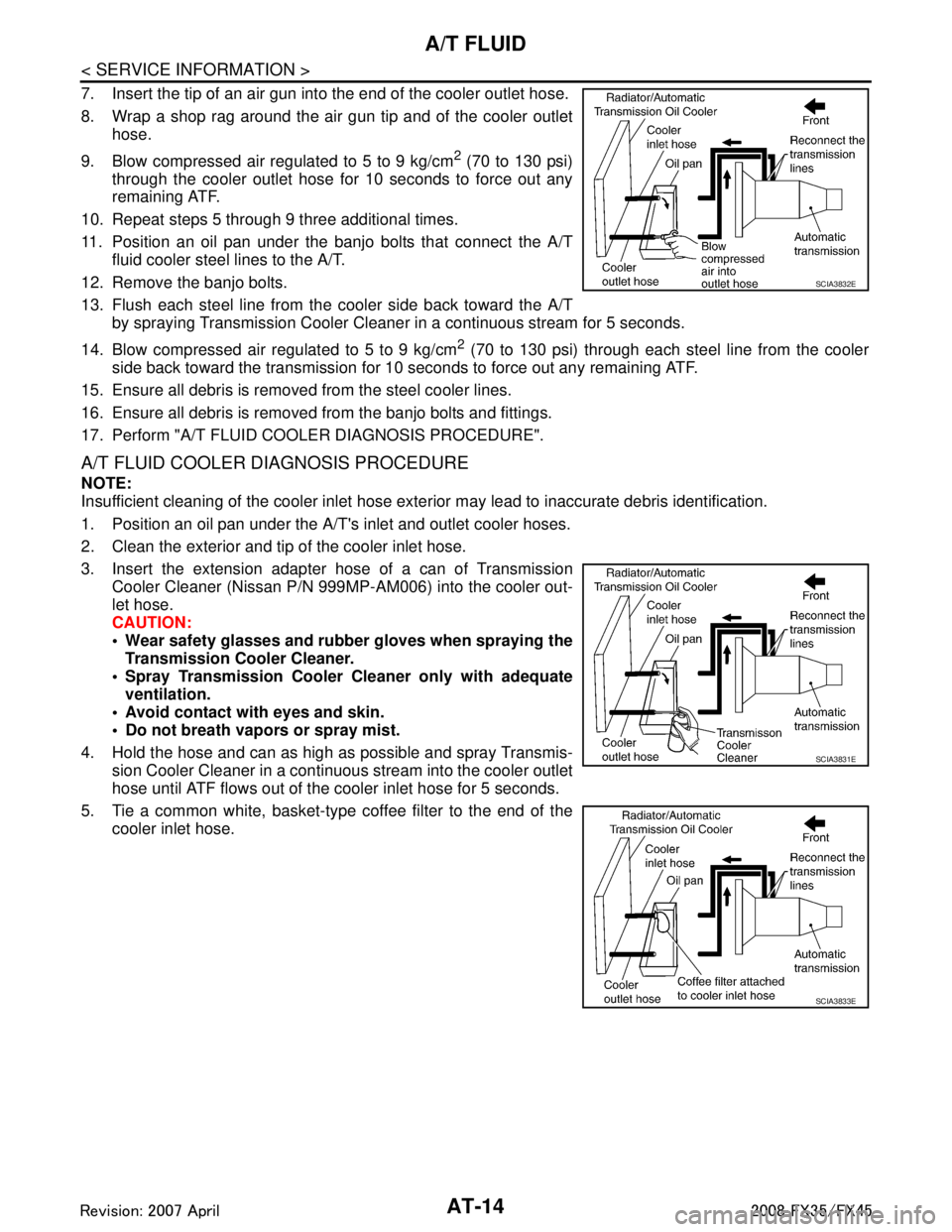
AT-14
< SERVICE INFORMATION >
A/T FLUID
7. Insert the tip of an air gun into the end of the cooler outlet hose.
8. Wrap a shop rag around the air gun tip and of the cooler outlethose.
9. Blow compressed air regulated to 5 to 9 kg/cm
2 (70 to 130 psi)
through the cooler outlet hose for 10 seconds to force out any
remaining ATF.
10. Repeat steps 5 through 9 three additional times.
11. Position an oil pan under the banjo bolts that connect the A/T fluid cooler steel lines to the A/T.
12. Remove the banjo bolts.
13. Flush each steel line from the cooler side back toward the A/T by spraying Transmission Cooler Cleaner in a continuous stream for 5 seconds.
14. Blow compressed air regulated to 5 to 9 kg/cm
2 (70 to 130 psi) through each steel line from the cooler
side back toward the transmission for 10 seconds to force out any remaining ATF.
15. Ensure all debris is removed from the steel cooler lines.
16. Ensure all debris is removed from the banjo bolts and fittings.
17. Perform "A/T FLUID COOLER DIAGNOSIS PROCEDURE".
A/T FLUID COOLER DIAGNOSIS PROCEDURE
NOTE:
Insufficient cleaning of the cooler inlet hose exte rior may lead to inaccurate debris identification.
1. Position an oil pan under the A/T's inlet and outlet cooler hoses.
2. Clean the exterior and tip of the cooler inlet hose.
3. Insert the extension adapter hose of a can of Transmission
Cooler Cleaner (Nissan P/N 999MP-AM006) into the cooler out-
let hose.
CAUTION:
Wear safety glasses and rubber gloves when spraying the Transmission Cooler Cleaner.
Spray Transmission Cooler Cleaner only with adequate
ventilation.
Avoid contact with eyes and skin.
Do not breath vapors or spray mist.
4. Hold the hose and can as high as possible and spray Transmis- sion Cooler Cleaner in a continuous stream into the cooler outlet
hose until ATF flows out of the cooler inlet hose for 5 seconds.
5. Tie a common white, basket-type coffee filter to the end of the cooler inlet hose.
SCIA3832E
SCIA3831E
SCIA3833E
3AA93ABC3ACD3AC03ACA3AC03AC63AC53A913A773A893A873A873A8E3A773A983AC73AC93AC03AC3
3A893A873A873A8F3A773A9D3AAF3A8A3A8C3A863A9D3AAF3A8B3A8C
Page 91 of 3924

AT-18
< SERVICE INFORMATION >
A/T CONTROL SYSTEM
Cross-Sectional View (V K45DE Models for AWD)
INFOID:0000000001327133
Shift MechanismINFOID:0000000001327134
The A/T uses compact triple planetary gear systems to improve power transmission efficiency, simplify con-
struction and reduce weight.
It also employs an optimum shift control and super wide gear ratios. They improve starting performance and
acceleration during medium and high-speed operation.
CONSTRUCTION
1. Front planetary gear 2. Mid planetary gear 3. Rear planetary gear
4. Direct clutch 5. High and low reverse clutch 6. Reverse brake
7. Drum support 8. Forward brake 9. Low coast brake
10. Input shaft 11. Torque converter 12. Oil pump
13. Front brake 14. 3rd one-way clutch 15. Input clutch
16. 1st one-way clutch 17. Control valve with TCM 18. Forward one-way clutch
19. Adapter case 20. Output shaft
SCIA5268E
3AA93ABC3ACD3AC03ACA3AC03AC63AC53A913A773A893A873A873A8E3A773A983AC73AC93AC03AC3
3A893A873A873A8F3A773A9D3AAF3A8A3A8C3A863A9D3AAF3A8B3A8C